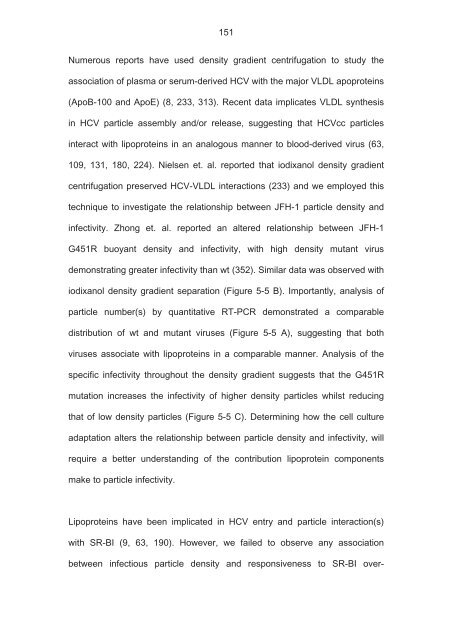The role of scavenger receptor BI in hepatitis - eTheses Repository ...
The role of scavenger receptor BI in hepatitis - eTheses Repository ...
The role of scavenger receptor BI in hepatitis - eTheses Repository ...
You also want an ePaper? Increase the reach of your titles
YUMPU automatically turns print PDFs into web optimized ePapers that Google loves.
151<br />
Numerous reports have used density gradient centrifugation to study the<br />
association <strong>of</strong> plasma or serum-derived HCV with the major VLDL apoprote<strong>in</strong>s<br />
(ApoB-100 and ApoE) (8, 233, 313). Recent data implicates VLDL synthesis<br />
<strong>in</strong> HCV particle assembly and/or release, suggest<strong>in</strong>g that HCVcc particles<br />
<strong>in</strong>teract with lipoprote<strong>in</strong>s <strong>in</strong> an analogous manner to blood-derived virus (63,<br />
109, 131, 180, 224). Nielsen et. al. reported that iodixanol density gradient<br />
centrifugation preserved HCV-VLDL <strong>in</strong>teractions (233) and we employed this<br />
technique to <strong>in</strong>vestigate the relationship between JFH-1 particle density and<br />
<strong>in</strong>fectivity. Zhong et. al. reported an altered relationship between JFH-1<br />
G451R buoyant density and <strong>in</strong>fectivity, with high density mutant virus<br />
demonstrat<strong>in</strong>g greater <strong>in</strong>fectivity than wt (352). Similar data was observed with<br />
iodixanol density gradient separation (Figure 5-5 B). Importantly, analysis <strong>of</strong><br />
particle number(s) by quantitative RT-PCR demonstrated a comparable<br />
distribution <strong>of</strong> wt and mutant viruses (Figure 5-5 A), suggest<strong>in</strong>g that both<br />
viruses associate with lipoprote<strong>in</strong>s <strong>in</strong> a comparable manner. Analysis <strong>of</strong> the<br />
specific <strong>in</strong>fectivity throughout the density gradient suggests that the G451R<br />
mutation <strong>in</strong>creases the <strong>in</strong>fectivity <strong>of</strong> higher density particles whilst reduc<strong>in</strong>g<br />
that <strong>of</strong> low density particles (Figure 5-5 C). Determ<strong>in</strong><strong>in</strong>g how the cell culture<br />
adaptation alters the relationship between particle density and <strong>in</strong>fectivity, will<br />
require a better understand<strong>in</strong>g <strong>of</strong> the contribution lipoprote<strong>in</strong> components<br />
make to particle <strong>in</strong>fectivity.<br />
Lipoprote<strong>in</strong>s have been implicated <strong>in</strong> HCV entry and particle <strong>in</strong>teraction(s)<br />
with SR-<strong>BI</strong> (9, 63, 190). However, we failed to observe any association<br />
between <strong>in</strong>fectious particle density and responsiveness to SR-<strong>BI</strong> over-

















